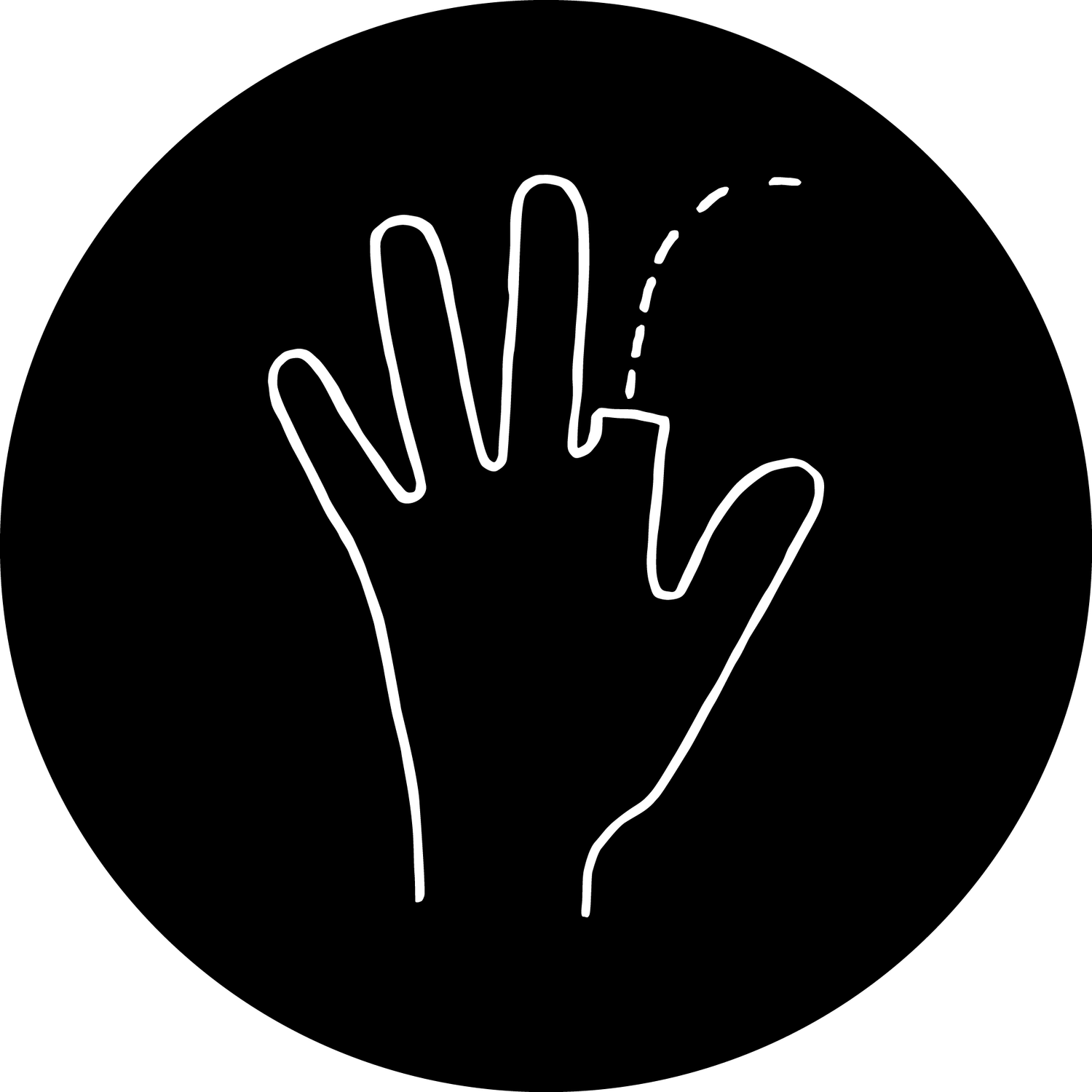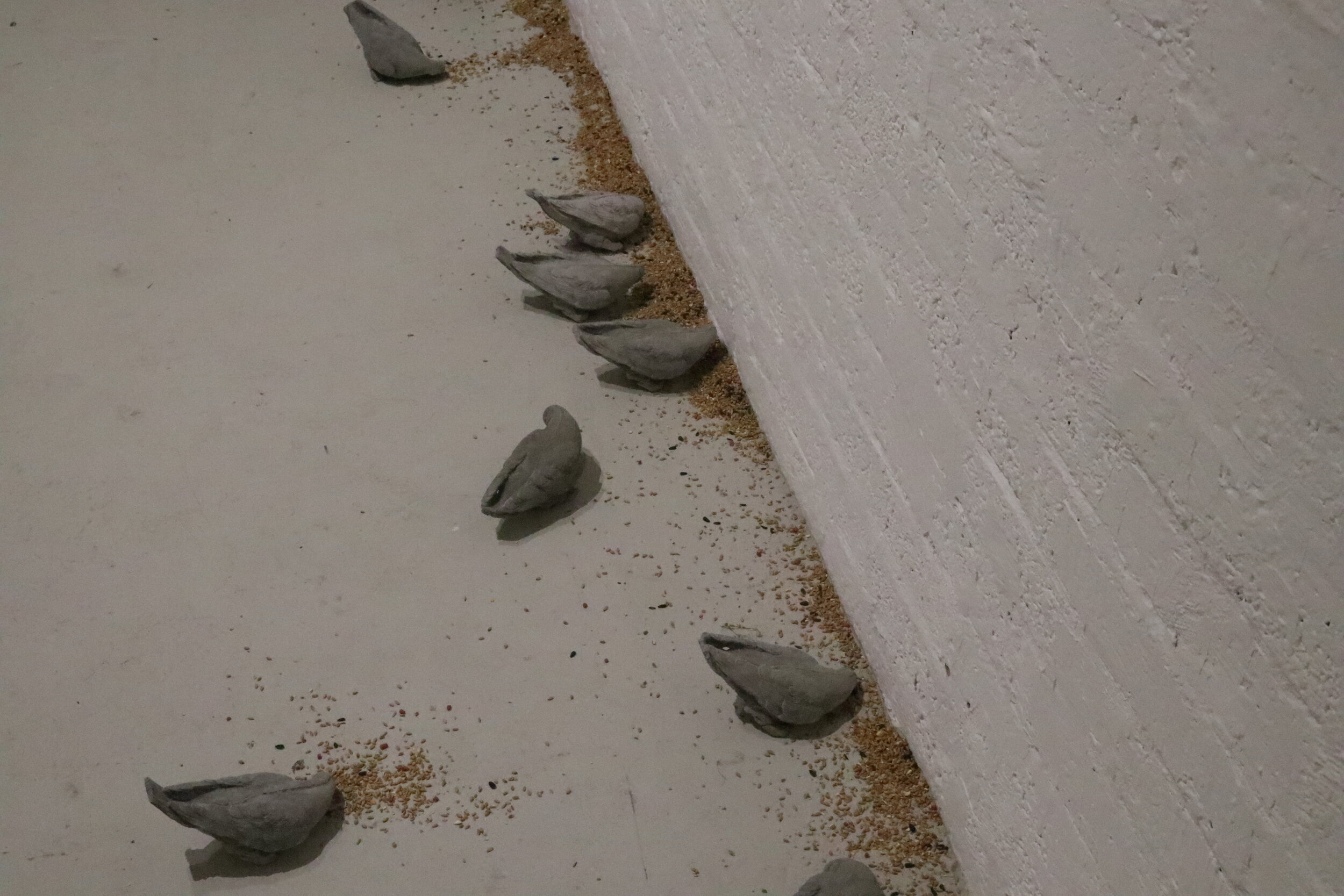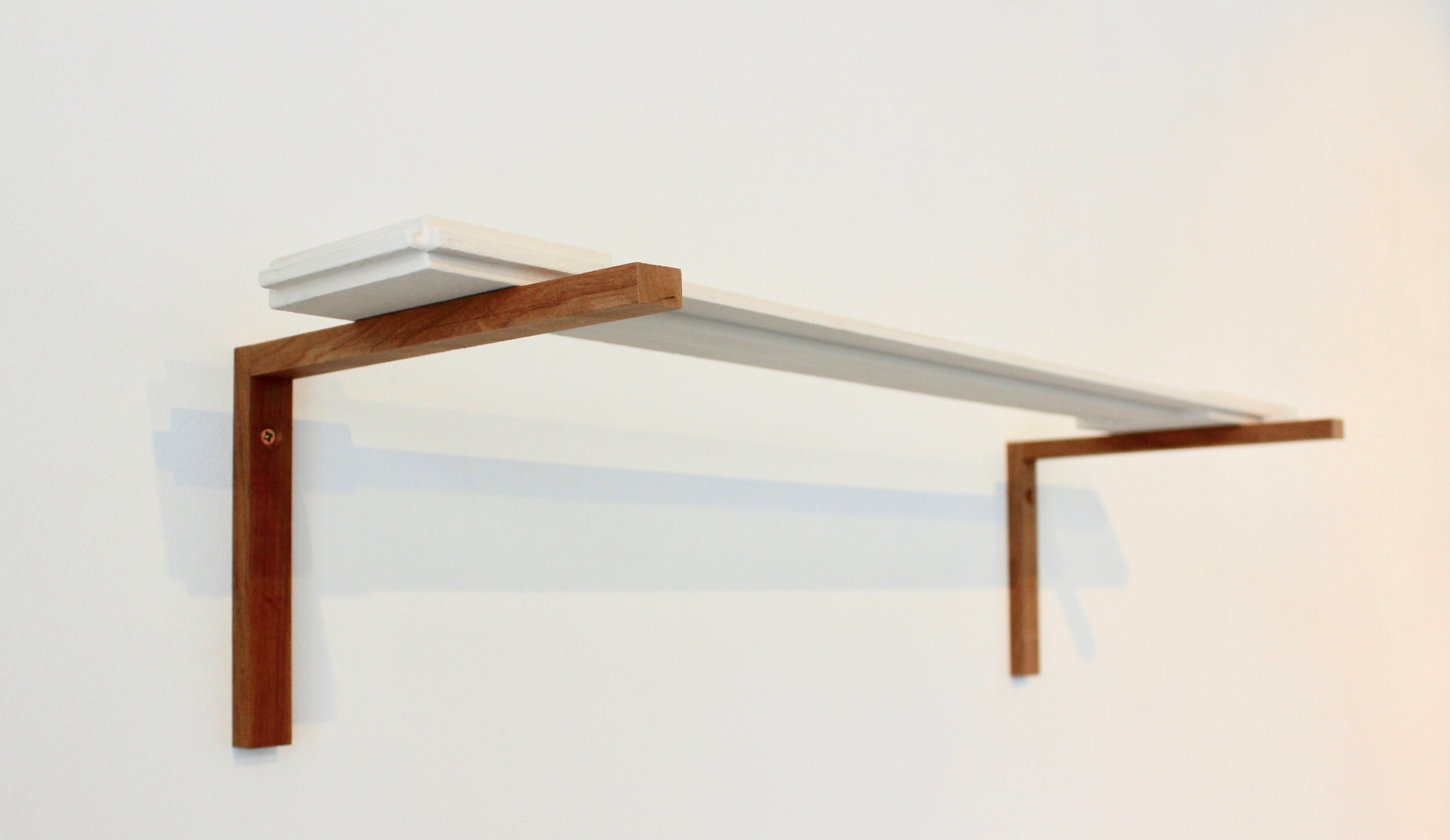“Good Luck, when you are out enjoying yourself.
Keeping looking.
Take this leaflet with you. Keep all your pockets closed.
Let him pay.
Mind what granny says
OK!”
If you missed the public opening of The Shake of the Tin last week, not to fear! We talked to Graduate Awardee Leoni Hill about relief found in humour, Granny’s sage advice and the ticking-over time of lockdown.
Catalyst Arts welcomes you to The Shake of the Tin, the premier solo show of Graduate Award 2019 winner Leoni Hill. Based in Belfast, visual artist Leoni Hill graduated with a BA Honours in Fine Art: Sculpture from Belfast School of Art and is currently a studio holder at Flax Art Studios. Her multidisciplinary practice takes the form of kinetic sculpture incorporating video and sound elements as well as performance and live work. As well as her presentation at Catalyst Arts, Leoni worked at the Belfast International Festival of Performance Art and has shown at Flax Studios thirtieth year anniversary show in 2020. She also showcased work at Queen Street Studios as well as The Royal Ulster Academy of Art Summer Show in 2019.
Leoni Hill’s practice is centered around the everyday. Her work relies on narratives that intertwine with her personal life. She ultises tropes of self deprecating humour with industrial materials to invite questions of sexuality, love and failures.
“The rattle as the bird feeder hits the sides of the tin, bringing the pigeons home for the day, altering the chicken of their supper.
The Shake of the Tin is the cherished sound of my grandfather doing what he onced loved, a sound that is now only a memory.”
Utilising the vulnerability and sensitivity to the subject of declining health and the life of the loved one, The Shake of the Tin is a recurring memory from the point of view of multiple relationships. The past and present relationships between a man and his family, and its legacy. Leoni Hill uses light hearted humour as a coping mechanism to disrupt internalised feelings towards the deteriorating, yet stable condition in which her grandfather is at present.
On the 16th March 2020, we began the process of installation with Leoni at Catalyst Arts, at that point, unaware of the severity of the global pandemic; a week later Northern Ireland was officially on lockdown and our decision to close the gallery was made. After a very successful adaption of the show to online, the installation has sat in the gallery and awaits its public viewing. During lockdown, we spoke to Leoni about the work and her practice:
CA (Catalyst Arts): You describe your practice as an observational tool documenting both the lighter and darker elements of ‘the everyday’. What is it about that concept that you find interesting as a starting point, is it the sense of the ordinary or the life changing moments that you are drawn to?
LH (Leoni Hill): I struggle to find things to do within art, so a lot of my ideas come from things I am going through and a way of expressing how I am feeling.
I move between the two. I find it hard to talk about things and keep a lot of things bottled up so making work about those things is easier. I would resonate with humour in art work in galleries, I like to make people laugh. It comes back to the mechanics of things, I am interested in how things work and the process of getting things to work. Once I have an elaborate idea I work out the mechanics of how it’ll work. I am always working that out, how things come together. I experiment, I’m guaranteed to fail a number of times before they do.
CA: With your past work, especially the work presented at your degree show in 2019, (‘Why is this failing?’, ‘Every holes a goal’ and ‘Shake is sexy mama’) there is a curiosity to see what is happening behind or away from the object, behind the scenes. Where does the curiosity in mechanics come from?
LH: No idea, I am not good at technology, I don’t know where that comes from.
CA: Those mechanics create a real personality they ‘perform’ are they characters?
LH: Yeah, especially when making the work they take their own character. I have someone in mind when I am making the work, they have their own life.
CA: Your interest in specific personalities seem to be really at the centre of your practice, it was interesting to watch when you were installing that you have a strong network around you. Does working in groups drive your practice forward.
LH: I found that my degree show was easier to make because I was surrounded by people in the same circumstances trying to make things as good as possible. It’s been harder since graduating trying to work out how to get things to work. Trying to figure it out on my own. I have struggled more.
Making in a space with others is really important, it gives you access to have other people's opinions and to be able to bat ideas off each other. Because I am so attached to the works, I see it in a particular way. I think it is important for someone to talk you away, ask questions and free your head up. When playing with installation it's important to have that free flowing conversation.
CA: Do you find working in groups easier, is it a way of working mechanics out?
LH: I go off other people's stress, I work off of other people.
CA: I know that you have worked with other artists before, at B.I.F.P.A. you worked with Brennagh Meehan, another friend and Catalyst Arts collaborator, have you explored other collaborative practices and would you approach it in similar ways to making sculpture?
LH: Not in terms of sculpture but collaborating, I would be interested in more.
The relaxed performance at B.I.F.P.A. of coffee being given out was repeated over the day. There is something very natural about performance for me. I do spend a lot of time researching the easiest way to do things [to make things work] with sculpture, whereas performance comes more easily.
CA: Your installation in Catalyst Arts, The Shake of the Tin is made up of multiple elements, one of which is a repeated percussion like sound that resonates in the space not only physically but also evokes an emotional response, this is clearly a sound of a very defined memory.
LH: Growing up my grandad always had pigeons and as a result became sick with ‘pigeon lung’ after that he kept chickens. He would always take us to show the pigeons, when he looked after us. He would shake the tin when it was time for the feed. He has dementia and is losing his memory. Talking to him whilst making the work would have brought back that time we had together. So it’s nice to go back to that time.
It's hard to understand how other people will view it because it is so specific to me and my family. It is nice how it resonates with other people and how they feel when they view it. Someone might hear it and have something very different in mind.
This is very different to work I have done before as this felt a lot more personal to me, and felt very open about a situation that was happening at that time that is upsetting but felt if you don't laugh you'll cry. I will always use humor to break up that sadness.
CA: ‘If you don’t laugh, you’d cry’ is a really interesting phrase, is this the way you insert humour into the work? Is that a tactic you have learnt for yourself, or do you think you might have inherited that from your grandparents?
LH: It would have been something a lot of my family do 100%, even now visiting them through the window there's a lot of humor.
CA: We started this article with a quote from your granny’s letter given to you, and now the audience has some sound advice on catching a partner.
LH: My granny who has a great sense of humour, gave a letter to me and my sisters. She is very morbid about her age and thought the worst when her husband had gotten sick and left instructions on how to find the perfect partner and the qualities she found in her husband, my grandfather. We all laugh about it.
Making the show virtual gave the opportunity for my granada and granny to see the show, which probably wouldn't have been a possibility, they don't do well with travel, it was great to see their reaction.
My whole family’s response was great, they know what I do but don't know what I do, and they all really resonated to it, as they are all going through this.
CA: It probably seems like a lifetime now as it feels so much has changed, but you graduated from Belfast School of Art in 2019 receiving the Catalyst Arts Graduate Award. How have things been a year on and having an opportunity to have a solo show in the gallery?
LH: At the beginning I was very nervous, the more time I spent there playing around with the installation it's nice to let the work breath. Having only a Degree Show as a comparison where a lot of people were cramped together. I could imagine my work within a larger scale. Even though this work is a little smaller. I have really fond memories of Catalyst, I was intimidated by the size, but knew the space well after working in it in second year. It is a great opportunity once you know the space. It's a great opportunity. In terms of the virtual graduate show we had an opening with a lot of friends.
CA: Going back to your peer community, there seems to be a really great relationship built from your time at art school. How is that helping support your practice, and do you have plans on working together again?
LH: We have always spoken about doing something together, whether that be a collective or a space. It's nice as recent graduates to have something to work on. Unless you have applied for something, you're making work and you're not too sure why.
Getting a space and getting people in and helping each other out. It's fun as well, it keeps the ideas rolling.
CA: Do you feel that there are those opportunities for recent graduates in Belfast?
LH: Yes and no, I landed on my feet in Flax and depending on what you do you might not need that studio space.
If I didn’t have Flax, I would have struggled because of the work I do, I wouldn't be able to do it at home. I had things to work towards after graduating, but it's intimidating because you have all this energy to make, with a wonder of what to do now. Applications are taught at uni, but at the same time, there is a lot of learning to do on your own after. And connections to outside artists are helpful.
CA: How have you found ‘lockdown’?
LH: I have done nothing! Not physically in terms of making new work, which is great! It’s nice to have a break. The brain is ticking and there are so many ideas and excitement for the studios to reopen.
During lockdown I have been working with a few other artists at Making Space. Making Space is a project designed to work as an exchange between artist and community. Making Space is located within Bow Street Mall, Lisburn however with lockdown in place we have not had access to the space. Instagram has been a platform in which we have been staying connected with each other and other artists, offering residencies and open call opportunities. The response has been great, it’s interesting having an insight as to how other artists have been coping in lockdown with the pressure of a global pandemic in our midst.
CA: What’s planned next?
LH: I have no idea, this has been a really good chance to think about the next step.
*The Shake of the Tin will reopen at Catalyst Arts on Thursday 16th July 2020 till Saturday 18th July 2020, and is viewable on the Catalyst Arts online archive.






















































